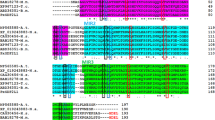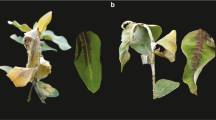Abstract
The smoke-tree vascular wilt fungus, Verticillium dahliae, was successfully transformed via PEG-mediated protoplasts using cassettes for eGFP and hygromycin B resistance (hph) gene expression. The transformants were stable after alternative sub-culturing on selective and non-selective medium for 6 months. The transformed isolates did not differ markedly from wild-type strains in terms of growth, morphological characteristics, asexual conidiation and pathogenicity. Fluorescence observations clearly indicated strong expression of the green fluorescent protein in fungal structures. The colonization and penetration of smoke-tree roots by eGFP-tagged V. dahliae was monitored by fluorescence, and the early infection processes were clearly visualized. At 24-hour-post-inoculation (hpi), hyphae were found to be predominantly colonizing the fibers rather than the taproots, and subsequently, hyphae started to grow parallel to the longitudinal axis of the root along the junctions of epidermal cells at 36 hpi. At 48 hpi, the elongated hyphae were interspersed among the root hairs and the first observation of central cylinder colonization occurred at 5 dpi. Elevated amounts of fungal DNA were detectable in stems 6 dpi, in branches 12 dpi, and in leaves 14 dpi. The data indicated that once V. dahliae enters smoke-tree, the pathogen rapidly spreads and increases in planta, and GFP can be used as a vital and stable marker for studying the interaction between V. dahliae and woody plants. Furthermore, the establishment of a PEG-mediated transformation system will contribute to functional genomics studies of smoke-tree Verticillium wilt fungus.






Similar content being viewed by others
References
Amey RC, Athey-Pollard A, Burns C, Mills PR, Bailey A, Foster GD (2002) PEG-mediated and Agrobacterium-mediated transformation in the mycopathogen Verticillium fungicola. Mycol Res 106:4–11
Bao S, Tao W, Tian C (2011) Histopathological response in the interaction between Cotinus coggygria and Verticillium dahliae. Sci Silvae Sin 47:58–65
Covert SF, Kapoor P, Lee M, Briley A, Nairn CJ (2001) Agrobacterium tumefaciens-mediated transformation of Fusarium circinatum. Mycol Res 105:259–264
Dobinson KF (1995) Genetic transformation of the vascular wilt fungus Verticillium dahliae. Can J Botany 73:710–715
Dobinson KF, Lecomte N, Lazarovits G (1997) Production of an extracellular trypsin-like protease by the fungal plant pathogen Verticillium dahliae. Can J Microbiol 43:227–233
Dobinson KF, Grant SJ, Kang S (2004) Cloning and targeted disruption, via Agrobacterium tumefaciens-mediated transformation, of a trypsin protease gene from the vascular wilt fungus Verticillium dahliae. Curr Genet 45:104–110
Eynck C, Koopmann B, Grunewaldt-Stoecker G, Karlovsky P, von Tiedemann A (2007) Differential interactions of Verticillium longisporum and V. dahliae with Brassica napus detected with molecular and histological techniques. Eur J Plant Pathol 118:259–274
Fitzgerald AM, Mudge AM, Gleave AP, Plummer KM (2003) Agrobacterium and PEG-mediated transformation of the phytopathogen Venturia inaequalis. Mycol Res 107:803–810
Fradin EF, Thomma BPHJ (2006) Physiology and molecular aspects of Verticillium wilt diseases caused by V. dahliae and V. albo-atrum. Mol Plant Pathol 7:71–86
Gao F, Zhou B, Li G, Jia P, Li H, Zhao Y, Zhao P, Xia G, Guo H (2010) A glutamic acid-rich protein identified in Verticillium dahliae from an insertional mutagenesis affects microsclerotial formation and pathogenicity. PLoS One 5:e15319
Gold J, Lee B, Robb J (1996) Colonization of tomatoes by Verticillium dahliae: determinative phase II. Can J Botany 74:1279–1288
Heinz R, Lee SW, Saparno A, Nazar RN, Robb J (1998) Cyclical systemic colonization inVerticillium-infected tomato. Physiol Mol Plant Pathol 52:385–396
Kistler HC, Benny UK (1988) Genetic transformation of the fungal plant wilt pathogen, Fusarium oxysporum. Curr Genet 13:145–149
Klosterman SJ, Atallah ZK, Vallad GE, Subbarao KV (2009) Diversity, pathogenicity, and management of verticillium species. Annu Rev Phytopathol 47:39–62
Klosterman SJ, Subbarao KV et al (2011) Comparative genomics yields insights into niche adaptation of plant vascular wilt pathogens. PLoS Pathog 7:e1002137
Lorito M, Hayes CK, Pietro A, Harman GE (1993) Biolistic transformation of Trichoderma harzianum and Gliocladium virens using plasmid and genomic DNA. Curr Genet 24:349–356
Markakis E, Tjamos S, Antoniou P, Paplomatas E, Tjamos E (2009) Symptom development, pathogen isolation and Real-Time QPCR quantification as factors for evaluating the resistance of olive cultivars to Verticillium pathotypes. Eur J Plant Pathol 124:603–611
Maruthachalam K, Klosterman SJ, Kang S, Hayes RJ, Subbarao KV (2011) Identification of pathogenicity-related genes in the vascular wilt fungus Verticillium dahliae by Agrobacterium tumefaciens-mediated T-DNA insertional mutagenesis. Mol Biotechnol 49:209–221
Mathur J, Koncz C (1998) PEG-mediated protoplast transformation with naked DNA. Methods Mol Biol 82:267–276
Mercado-Blanco J, Rodríguez-Jurado D, Parrilla-Araujo S, Jiménez-Díaz RM (2003) Simultaneous detection of the defoliating and nondefoliating Verticillium dahliae pathotypes in infected olive plants by duplex, nested polymerase chain reaction. Plant Dis 87:1487–1494
Michielse CB, Hooykaas PJJ, van den Hondel CAMJJ, Ram AFJ (2005) Agrobacterium -mediated transformation as a tool for functional genomics in fungi. Curr Genet 48:1–17
Ozeki K, Kyoya F, Hizume K, Kanda A, Hamachi M, Nunokawa Y (1994) Transformation of intact Aspergillus niger by electroporation. Biosci Biotechnol Biochem 58:2224–2227
Prieto P, Navarro-Raya C, Valverde-Corredor A, Amyotte SG, Dobinson KF, Mercado-Blanco J (2009) Colonization process of olive tissues by Verticillium dahliae and its in planta interaction with the biocontrol root endophyte Pseudomonas fluorescens PICF7. Microb Biotechnol 2:499–511
Ruiz-Diez B (2002) Strategies for the transformation of filamentous fungi. J Appl Microbiol 92:189–195
Vallad GE, Subbarao KV (2008) Colonization of resistant and susceptible lettuce cultivars by a green fluorescent protein-tagged isolate of Verticillium dahliae. Phytopathology 98:871–885
Visser M, Gordon TR, Wingfield BD, Wingfield MJ, Viljoen A (2004) Transformation of Fusarium oxysporum f. sp. cubense, causal agent of Fusarium wilt of banana, with the green fluorescent protein (GFP) gene. Australasian Plant Pathol 33:69–75
Wang J, Tian C, Ge J (2008) Research progress of the tree wilt disease caused by Verticillium. Forest Pest Dis 10:30–36 (in Chinese)
Weiland JJ (2003) Transformation of Pythium aphanidermatum to geneticin resistance. Curr Genet 42:344–352
Weld RJ, Plummer KM, Carpenter MA, Ridgway HJ (2006) Approaches to functional genomics in filamentous fungi. Cell Res 16:31–44
White T, Streips UN (1986) Methods to enhance uptake of DNA in polyethylene glycol-mediated transformation. J Microbiol Methods 5:191–198
Acknowledgements
This work was supported by the Fundamental Research Funds for Beijing Forestry University Young Scientist Foundation (BLX2009014), and NSFC Project (C160901) to W.Y.L.
Author information
Authors and Affiliations
Corresponding author
Rights and permissions
About this article
Cite this article
Wang, Y., Xiao, S., Xiong, D. et al. Genetic transformation, infection process and qPCR quantification of Verticillium dahliae on smoke-tree Cotinus coggygria . Australasian Plant Pathol. 42, 33–41 (2013). https://doi.org/10.1007/s13313-012-0172-0
Received:
Accepted:
Published:
Issue Date:
DOI: https://doi.org/10.1007/s13313-012-0172-0




